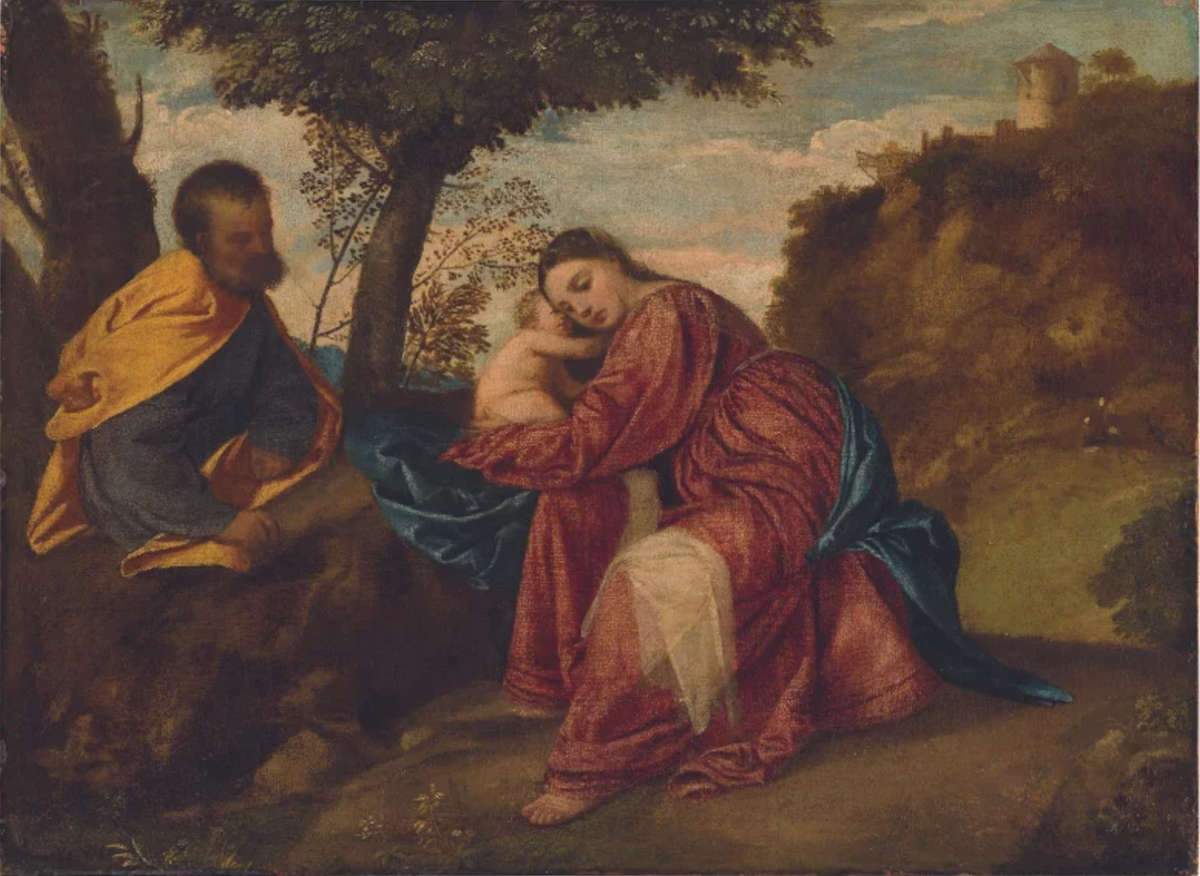An early masterpiece by Titian (Pieve di Cadore, 1488/1490 - Venice, 1576), Rest during the Flight into Egypt, makes its market debut after more than 145 years at Christie’s Old Masters Part I auction on July 2, 2024. The work has an estimate of 15-25 million pounds (17.48-29.13 million euros). Among the few remaining religious works from the early stages of the artist’s career, this canvas has traveled through some of Europe’s most distinguished collections and was last offered at auction by Christie’s in 1878 before joining the prestigious Longleat House collection.
The painting’s journey begins in the collection of Venetian merchant Bartolomeo della Nave (1571/79-1632). Della Nave’s inventory reveals an extraordinary collection, including fifteen works by Titian, such as the famous Gypsy Madonna of c. 1511, the Violante of c. 1510-15, the Nymph and the Shepherd of c. 1570, all of which are housed in Vienna’s Kunsthistorisches Museum, and the mature Death of Actaeon of 1565-76, now at the National Gallery in London. In 1636, Longleat’s painting was valued at 200 lire in Della Nave’s inventory, double the amount for the Death of Actaeon, suggesting a greater appreciation for Titian’s early works than his later ones. Most of the collection was purchased en bloc by his brother-in-law the Duke of Hamilton and sent to England. After Hamilton’s execution by parliament in 1649, the collection was sold to Archduke Leopold Wilhelm of Austria, governor of the Spanish Netherlands from 1647 to 1656. The painting appears in Teniers’ copper depicting Archduke Leopold Wilhelm in his Pinacoteca in Brussels (Madrid, Prado Museum), where it is displayed along with other Titian works acquired from the Della Nave collection, including the Nymph and the Shepherd, Violante, and his Christ and the Adulteress of c. 1511, an unfinished panel that the young Antoon van Dyck had sketched during his visit to the Venetian merchant’s collection in 1622. Longleat’s painting remained in the imperial collection and was moved to the Belvedere Palace in Vienna in 1781, where it was looted by French troops in 1809 for the Musée Napoléon. It was later owned by Hugh Andrew Johnstone Munro of Novar (1797-1864), a Scottish landowner, amateur artist, and one of Turner’s most important patrons. Munro formed a celebrated collection that included Rembrandt ’s Lucretia and Veronese’s Vision of St. Helena .

The Rest during the Flight into Egypt entered the collection of the fourth Marquis of Bath back in 1878, over 145 years ago. The painting attracted attention in 1995 when it was stolen by Longleat. Seven years later, in 2002, after a £100,000 reward was offered for information helpful in its safe return, the painting was found in a shopping bag in Greater London. Although it was missing its frame, its discovery was made possible by Charles Hill, an art detective at the time and former Scotland Yard officer. The painting has elicited variations in precise dating over time. In the 2012 exhibition at the National Gallery in London entitled Titian, A Fresh Look at Nature, curated by Antonio Mazzotta, the painting was dated to around 1508-1509. Mazzotta notes that the imposing figure of the Virgin “anticipates other Titian heroines” of the period, particularly that of Judith or Justice in the fragment of a fresco detached from the entrance to the Merceria at the Fondaco dei Tedeschi, dating from about 1508 (Venice, Ca d’Oro), one of the key early commissions, and that of Magdalene in the artist’s slightly later Noli me Tangere, dated 1511-12. In his review of the 2012 exhibition at the National Gallery, which focused on Titian’s 1506-7 Rest during the Flight into Egypt (St. Petersburg, Hermitage), Paul Hills admired Longleat’s painting for the artist’s masterful use of color: “The red of the Virgin’s robe, contrasted by the [white] napkin, is treated with marvelous breadth, and the ultramarine of her cloak spreads over the bank to meet the strong amber of Joseph’s mantle, which in turn contrasts with the purple of his robe. The solicitous movement of the figures, offset by the tilt of the tree trunks, is underscored by this drama of color.”
Orlando Rock, president of Christie’s UK, commented, “This sublime early masterpiece is one of the most poetic products of Titian’s youth. Of impeccable provenance and having passed through the hands of dukes, archdukes and emperors of the Holy Roman Empire, this magical devotional painting has the rare notoriety of having been stolen not once but twice: first by Napoleon and second in the late mid-1990s. We are honored to be commissioned to bring this important and beautifully observed painting to the London market this July.”
Andrew Fletcher, global head of Christie’s Old Paintings Department, commented, “This is the most important work by Titian to come to the auction market in more than a generation and one of the artist’s very few masterpieces remaining in private hands. It is a painting that embodies the pictorial revolution wrought by Titian in the early 16th century and is a truly outstanding example of the artist’s pioneering approach to both the use of color and the depiction of the human form in the natural world, the artistic vocabulary that secured his status as the first Venetian painter to achieve fame throughout Europe during his lifetime and his position as one of the greatest painters in the history of Western art.”
 |
| London, Titian's twice-stolen early masterpiece goes up for auction at Christie's |
Warning: the translation into English of the original Italian article was created using automatic tools. We undertake to review all articles, but we do not guarantee the total absence of inaccuracies in the translation due to the program. You can find the original by clicking on the ITA button. If you find any mistake,please contact us.